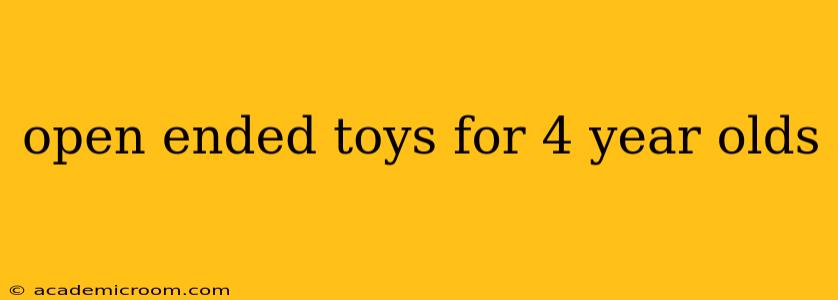Four-year-olds are bursting with imagination and curiosity. Open-ended toys, unlike toys with a single prescribed function, allow for boundless creativity and exploration. These toys encourage imaginative play, problem-solving, and the development of crucial cognitive and social skills. This guide explores the best open-ended toys for 4-year-olds, addressing common parent questions and providing insightful recommendations.
What are open-ended toys?
Open-ended toys are toys that don't have one specific way to be played with. They lack rigid rules and instructions, allowing children to use their imagination to determine how they will be used. This fosters creativity, problem-solving, and adaptable thinking. Unlike a toy that only does one thing, open-ended toys can transform into countless possibilities depending on the child's imagination. Think building blocks that can become a castle, a spaceship, or even a towering robot.
What are some examples of open-ended toys for 4-year-olds?
Building Toys:
- Large wooden blocks: These classic toys offer endless possibilities for construction, fostering spatial reasoning and problem-solving skills. The simplicity allows for imaginative play—a tower can become a castle, a bridge, or even a rocket ship.
- Magnetic tiles: These versatile tiles allow for both 2D and 3D creations, enhancing fine motor skills and encouraging creativity. Their magnetic properties add an element of physics to the play, allowing children to discover how magnetic forces work.
- LEGO Duplo: While technically a branded toy, Duplo blocks provide a great stepping stone to regular LEGOs and are large enough for small hands. They encourage similar creative construction opportunities.
Creative and Imaginative Play Toys:
- Play silks: These lightweight, flowing fabrics inspire imaginative play, whether it's building a fort, creating costumes, or simply enjoying the sensory experience of the fabric.
- Dress-up clothes: Clothes from previous generations can be surprisingly fun for imaginative play; they help foster role-playing and storytelling abilities.
- Art supplies: Crayons, paints, clay, and construction paper encourage self-expression and creativity. The lack of prescribed outcomes is key to their open-ended nature.
- Play Dough/Modeling Clay: These provide endless possibilities for sculpting and shaping, strengthening fine motor skills and promoting creative expression.
Other Open-Ended Toys:
- Loose parts: Collections of natural materials like sticks, stones, leaves, or shells can inspire imaginative play and building. These also introduce kids to different textures and materials.
- Simple vehicles: Wooden cars, trains, or boats provide a base for imaginative scenarios without imposing limitations on the kind of story or game that can be played.
What are the benefits of open-ended toys for 4-year-olds?
Open-ended toys offer a multitude of benefits for developing children:
- Enhanced creativity and imagination: They allow children to create their own stories, rules, and scenarios, fostering imagination and problem-solving abilities.
- Improved fine motor skills: Many open-ended toys, such as building blocks and play dough, require the manipulation of small objects, improving dexterity and coordination.
- Boosted cognitive development: Open-ended play encourages problem-solving, spatial reasoning, and critical thinking.
- Social and emotional development: Playing with open-ended toys can be a social activity, encouraging collaboration, communication, and negotiation.
How do I choose the right open-ended toy for my 4-year-old?
Consider your child's interests and developmental stage. Observe their play style—do they prefer building, creating stories, or acting things out? Choose toys that align with their preferences and provide opportunities for exploration and discovery. Durability is also important; opt for well-made toys that will withstand enthusiastic play. Prioritize safety, ensuring any toy is age-appropriate and free from choking hazards.
What are some open-ended activities I can do with my 4-year-old?
Beyond toys, everyday objects can be repurposed for open-ended play. A cardboard box can become a house, a spaceship, or even a magical portal. Pots, pans, and wooden spoons can become instruments or tools for a kitchen-based play. Remember, the possibilities are limitless!
Are open-ended toys better than structured toys?
Both types of toys offer benefits. Structured toys might teach specific skills, but open-ended toys foster a broader range of abilities, including creativity and problem-solving. A balanced approach, incorporating both types of toys, is often ideal.
How can open-ended toys help my child's development?
Open-ended play allows children to take the lead in their learning journey. The lack of set rules means they can explore different possibilities and solutions, fostering independent thought and building confidence. It also promotes social skills, as sharing and cooperating are often part of playing with open-ended toys.
This guide aims to provide parents with valuable insights into selecting and using open-ended toys for 4-year-olds. By embracing the power of open-ended play, you can encourage your child’s creativity, imagination, and overall development. Remember, the best toy is often the one that sparks the most imagination.
